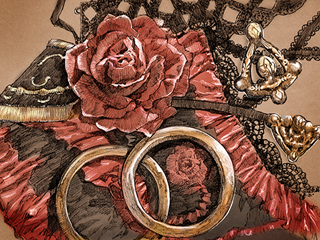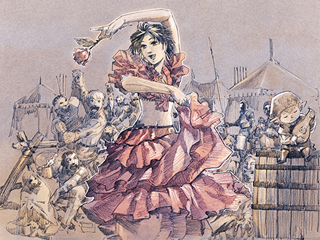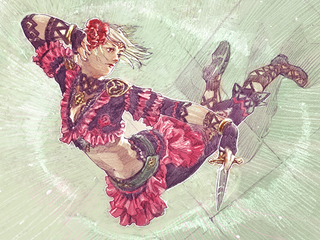|
Dancers, Maidens of the Battlefield (10/22/2007)
|
Maiden of the Battlefield'Tis the beatin' of the heart what lays the foundation. Ye embrace it with yer whole body, and then e'er so gently start tappin' out the steps. Yer blood gets t'bubblin' an' ye can hear it percolatin' about in there. An' then ye might stick a twirlin' turn and send it rushin' t'all yer extremities. Shimmies straight up the spine and sends a shudder clean through ye, it does. After that, then she's mine an' no mistakin'. Haven't the faintest where I be or how I got there, I just am. An' everyone around fuels me, each of 'em offerin' up their own music--a symphony o' souls. An' that's yer rhythm. Ye cannot help but dance. [Dancer Laila Brilioth, following a seminal performance on Jeuno's Artisan Bridge in the year 884]
The origins of the esoteric tradition known as the Kriegstanz are revealed below. Revelry in TotentanzCome now, and dance with these bones!
[a verse from the ancient "Bastokan Song of the Damned"]
On top of the already horrific and growing number of victims, unsubstantiated rumors and utter despair spread rampant through all quarters of the city. It was in this climate of social turmoil that the Bastokan Song of the Damned was taken up by the masses. Using magic to animate the remains of the deceased, throngs of the hopeless and grieving would choke the streets in processions of living and dead, booming in chorus as they danced the Totentanz in a form of morbid catharsis. Despite the government's initial efforts to quarantine those infected by the blight, the frenzied nightly gatherings were at first reluctantly tolerated. This changed however, as the growing popularity of the Totentanz carried it to the frontlines of battle, where the crazed enthusiasm generated by the now ritualistic dancing led no small number of soldiers to neglect their posts. This being an unacceptable state of affairs in wartime, a series of prohibitions was promptly issued with unforeseen results... An air of insurgency and rebellion swept the people, as dancing crowds began to take to the streets even with the sun still high in the sky. President Wilhelm was left with no recourse but to declare a state of emergency and mobilize the republic's main garrison of Galkan troops against the citizenry to suppress the escalating chaos. It is indeed a sad page in Bastokan history. It so happened that in those days, mountainfolk from the hinterlands of the Gustaberg region would sometimes travel to Bastok to peddle medicinal herbs. The quelling of the near-maniacal outbreaks of saturnalia would find its form in the native dancers of these tribes. With no hesitation despite the apparent dangers of contagion to themselves, they would roam the city streets and visit barracks, displaying the aggressive yet graceful steps of their people's traditional dance, the Kriegstanz, with a timeless elegance. The majestic rhythms pounded out by these confident women and their motions, full of life, captivated observers instantaneously. And it was not long before the morose Totentanz rituals faded away as quickly as they had come. Some years later, the significant role the dancers played in the defeat of the deadly epidemic which claimed so many Bastokan lives was commemorated by the president in a now famous speech: "Though none can deny the scientific strides made by our great alchemists in curing this foul plague, praise is due also to those fearless masters of dance who came to us in our most dire hour. For it was their impassioned artistry that delivered us from the tyranny of this most lethal of epidemics, and the terror which had fast gripped our very hearts." And so it was that the dancers came to be credited with ending the Bastokan Blight. In wake of its success and popularity during the blight, the Kriegstanz became a well-established school of dance, the study of which was such a grueling task that finding successors to carry on the tradition became quite a chore in its own right. It is not without some hint of irony that the second coming of the dancers would require a tragedy on the scale of the Crystal War--with the very fate of Bastok in the balance--to bring it about. Knowing KriegstanzOne would be remiss to relegate the arts of
Held in high regard as both first-class entertainers and as accomplished martial artists, the dancers are driven by an insatiable passion for their art. Entirely devoid of timidity on both the stage and the battlefield, dance requires the most absolute resolve. Only one who has honed these traits and devoted their very life to the beauty and perfection of the art itself is worthy of being deemed "Dancer." |





